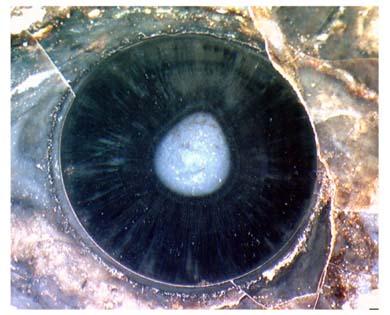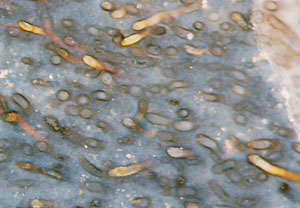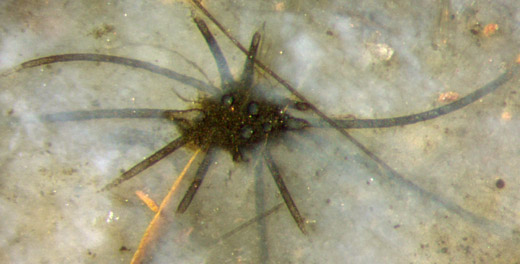Nematophytes
A brief introduction
 The nematophytes, which means
"filamentous plants", are known for about 150 years as fossils from
the Silurian and Lower Devonian but they are still so poorly understood
that lately they are not even listed among plant fossils but more
cautiously under "Enigmatic Organisms" [1] (**). Their sizes and shapes
range from millimeter-size spheres (Pachytheca,
see picture) and centimeter-size flaps
(Nematothallus
[2],
Nematophyton
and others, see picture below) to meter-size trunks
(Prototaxites)
[3].
The nematophytes, which means
"filamentous plants", are known for about 150 years as fossils from
the Silurian and Lower Devonian but they are still so poorly understood
that lately they are not even listed among plant fossils but more
cautiously under "Enigmatic Organisms" [1] (**). Their sizes and shapes
range from millimeter-size spheres (Pachytheca,
see picture) and centimeter-size flaps
(Nematothallus
[2],
Nematophyton
and others, see picture below) to meter-size trunks
(Prototaxites)
[3].
Essentially they are made up of two or more
types of filaments which nearly always appear as empty tubes. The tubes
typically form a chaotic tangle (*) with a more or less distinct
preference
for some plane or direction. In some species, part of the filaments are
aligned perpendicular to the surface, most perfectly so in the case of Pachytheca.

Nematophytes are very rare fossils in the
Lower Devonian Rhynie
chert but the few specimens found lately provide answers
to some of the questions lingering in the literature for a long time.
However, they pose new questions, too, as it is apparent from the
picture below right.
The nematophytes from
the Rhynie chert
represent at least 7
species, among them non-described ones. The
tubes of the live nematophytes seem to have been embedded in gel.
The unexpected
cellular patterns known as Nematothallus
cuticles, often seen together with coalified
filaments, are tentatively explained
here as not related to cells. 
The much bigger enigma of Prototaxites
has aroused the imagination of scientists as well as fossil collectors,
giving rise to wild speculations (as well as thorough investigations
***) ever since it was discovered. The latest attempt to demystify the
great Prototaxites
by
assorting it with humble liverworts (**) has been thwarted
with the help of
small nematophytes from the Rhynie chert [4].
Lately, Nematoplexus
has turned
out more enigmatic than previously thought, with details never seen
before, as the big "knot" in this image on the
right.
* On the Aberdeen Univerity website [5], the
characteristic feature of Nematoplexus,
the
spirally wound tubes, is ascribed to virtually all nematophytes
although it applies to Nematoplexus only.
**
Also in [1], chapter on bryophytes, it is proclaimed that "One
interesting hypothesis suggests that several of the enigmatic ...
nematophytes may represent remains of ancient liverworts ...
. ... At
least some of the tubular aggregations assigned to nematophytes have
been reinterpreted as ... liverwort rhizoids, ... ." That hypothesis is
refuted in Rhynie
Chert
News 41.
For new developments see [6] and the discussion in Rhynie
Chert News
30.
***
Now that the famous nematophyte Prototaxites is
interpreted as a huge fungus or lichen [7,8] and the less known small Nematophyton taiti
[9] from Rhynie has been re-named Prototaxites taiti
[10], the startling question arises whether or not more nematophytes are
really fungi or lichens.
H.-J.
Weiss
updated 2016, 2017, 2018,
2019,
re-arranged 2019, updated 2020
[1] T.N. Taylor,
E.L.Taylor, M. Krings: Paleobotany, Elsevier 2009.
[2] P. K. Strother:
Clarification of the genus Nematothallus.
J. Paleont. 67 (1993),
1090-94.
[3] H. Steur:
http://www.xs4all.nl/~steurh/
[4] H.-J.
Weiss: Enigmatic Organisms - Insights
derived from new finds, Poster presentation, EPPC Budapest
2010.
[5]
www.abdn.ac.uk/rhynie/nemato.htm
[6] M.R. Smith, N.J.
Butterfield:
A new view on Nematothallus:
Coralline Red Algae from the Silurian of Gotland.
Palaeontology 56(2013), 345–357.
[7] F.M. Hueber:
Rotted wood-alga-fungus: the history and life of Prototaxites Dawson
1859. Rev. Palaeobot. Palynol. 116 (2001), 123–158.
[8] C.K. Boyce et al.: Devonian landscape heterogeneity recorded by a giant fungus. Geology 35 (2007), 399–402.
[9] R.
Kidston, W.H. Lang : On Old Red Sandstone
plants showing structure ..., Part V. Trans. Roy. Soc. Edinburgh 52
(1921),
855-902.
[10] R.
Honegger, D. Edwards, L. Axe, Ch. Strullu-Derrien:
Fertile Prototaxites
taiti: a basal ascomycete with
inoperculate, polysporous asci lacking croziers.
Phil. Trans. Roy. Soc. B 373 (2017): 20170146.
Listed below are the links to the contributions in Rhynie
Chert News, brief
descriptions, and the labels of the
samples in the own collection.
Pachytheca
1
Pachytheca, first
specimen in chert, central
cut Rh11/1.1
36
Pachytheca,
first specimen in chert, off-centre
cut Rh11/1.2
44
Pachytheca
– a
nematophyte propagule ?
Rh11/1.1
Nematoplexus
29
Nematoplexus,
bigger tubes than type specimem, new species ?
Rh9/86.2
39
Nematoplexus
with a wry twist ?
[5]
Rh9/86
51
spiralling
and
weakly curved tubes
Rh9/86.1,2
71
new type of knot and tubes
Rh15/79.1,4
102
spirals with
5 turns
and various other tubes
Rh15/79.1-4
106
Nematoplexus big
and small, new charophyte gametangia, Castracollis
Rh9/86.2
122
Nematoplexus
size data, Nematothallus
tube wall pattern
Rh9/86.1,2
123
solitary
spiral with 3 turns among Palaeonitella
Rh5/3.2
126
enigmatic knots of Nematoplexus
from several samples
Rh6/102 Rh9/86.2
Rh15/79.1,2
133
detached spirals near old knot with much narrower tubes
emerging Rh13/35.1
134
spirals apparently emerging from the central clot of the
knot Rh15/79.4
135
Nematoplexus
- thrice enigmatic
Rh15/79.1
136 tubes
spiralling and straight
Rh9/86.1,2
137
Nematoplexus
surprisingly polymorphic
Rh6/102
151
Nematothallus
and Nematoplexus
in one chert sample Rh9/86
152 tubes
at Nematoplexus knots
Rh15/79 Rh14/35
156.
varied nematophytes in Rhynie chert
Rh9/86.1 Rh15/79 Rh2/81 Rh13/7.1 Rh3/9.1 Rh13/1.2
Rh2/7.6
158 Nematophyte tubes and "branch knots" Rh2/81.3 Rh13/7.1 Rh15/79.4
Other Nematophytes
13
weft of big tubes, new species
?
Rh13/7.1
30
pseudo-cells
"Nematothallus
cuticle" explained
Rh2/81.1
35
flat nematophyte, Nematophyton taiti
(?) Rh2/7.6
38
no
liverwort connection of nematophytes and
Prototaxites
Rh2/81.1,3
40
wilting big tubes, decaying organic
gel
Rh13/7.2
Rh2/81.1,3
41
no liverwort connection of Cosmochlaina
and Prototaxites
46
flat
nematophyte, Nematophyton
taiti
(?) –
details and reconstruction
Rh2/7.6
86
tangle of very thin tubes,
6-8Ám
Rh3/9.1,2
92
glades in the
weft of big tubes
Rh2/81.3
98
weft of big tubes in a gel lump with
dried-up surface layer
Rh13/7.1,2
99
weft of narrow tubes with peculiar
details
Rh13/1.2
107
first 3D-Nematothallus
Rh9/86.1,2
122
Nematothallus
tube wall pattern, Nematoplexus
size data,
Rh9/86.1,2
151
Nematothallus
and Nematoplexus
in one chert sample Rh9/86
153
flat nematophyte - a fungus
?
Rh2/7
154 big tubes with settled tiny grains inside Rh2/81.1
155 Nematophyte twice protected Rh13/7.2
156.
varied nematophytes in Rhynie chert
Rh9/86.1 Rh15/79 Rh2/81 Rh13/7.1 Rh3/9.1 Rh13/1.2
Rh2/7.6
157. tracheid-like tubes in Rhynie chert Rh9/86.1,2 Rh9/33.1
158 Nematophyte tubes and "branch knots" Rh2/81.3 Rh13/7.1 Rh15/79.4
 The nematophytes, which means
"filamentous plants", are known for about 150 years as fossils from
the Silurian and Lower Devonian but they are still so poorly understood
that lately they are not even listed among plant fossils but more
cautiously under "Enigmatic Organisms" [1] (**). Their sizes and shapes
range from millimeter-size spheres (Pachytheca,
see picture) and centimeter-size flaps
(Nematothallus
[2],
Nematophyton
and others, see picture below) to meter-size trunks
(Prototaxites)
[3].
The nematophytes, which means
"filamentous plants", are known for about 150 years as fossils from
the Silurian and Lower Devonian but they are still so poorly understood
that lately they are not even listed among plant fossils but more
cautiously under "Enigmatic Organisms" [1] (**). Their sizes and shapes
range from millimeter-size spheres (Pachytheca,
see picture) and centimeter-size flaps
(Nematothallus
[2],
Nematophyton
and others, see picture below) to meter-size trunks
(Prototaxites)
[3].
